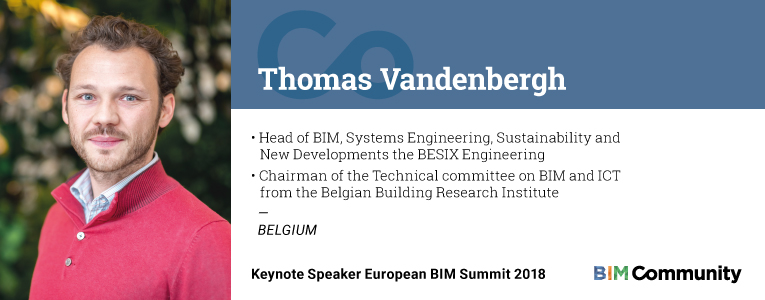Thomas Vandenbergh: "Belgium is not a front runner, but sub topper on European level and caching up the toppers very fast"
He is the chairman of the Technical committee on BIM and ICT from the Belgian Building Research Institute

T.V: Obtaining the BIM level 2 certification, is not only an important recognition of our BIM competencies towards the external world, but it also significantly contributes to the internal valorization of our BIM departments. We proved that all the efforts we have undertaken on BIM since 2010 lead to an international certificate. Key to this succes is the ability to translate our daily information management activities in clear activity flowchart and templates. A correct documentation of your procedures is fundamental to a correct understanding and an efficient roll out.
BC: Which has been the hardest part of the BESIX Group's BIM Journey?
BC: As the Chairman of the Technical Committee on BIM and ICT at Belgian Building Research Institute, what do you think is the main challenge for Belgium to implement BIM in public and private institutions?
BC: How does the Belgian construction sector integrate the digital information management? Which is the role/part of BBRI on this?
T.V: Some recent studies show that Belgium is not a front runner, but sub topper on European level and is caching up the toppers, like the Netherlands, very fast. The different initiatives lead by the BBRI, are certainly contributing to the faster and better adoption of BIM and new opportunities created by digitization. 2 examples: the BBRI recently launched a very practical guideline to establish a BIM protocol and execution plan on a project, and in a couple of weeks they will also publish a tool to efficiently look for BIM trainings given in Belgium, based on a very user friendly and efficient data base.
BC: Is the Government involved in boosting and promoting BIM in the Belgium AEC sector (any national strategy, mandates, relative regulations)?
T.V: It is obvious that the more the stakeholders have BIM experience and the more integrated the contract type, the higher the BIM adoption on a project. Nevertheless, we try to have a very 'tailor made' BIM approach. On every project one shall set up a Building Information Management strategy and objectives which are in line with the project risks and opportunities. Starting from this logic, BIM can be implemented everywhere, by everyone. But adapted to the context. Hence there is no single way to do BIM.
BC: Please, let us know something about your participation to the upcoming European BIM Summit on the 8th and 9th of March. What we can expect from your presentation?
T.V: Given the expert audience I'll be presenting to, I did not want to sell or convince about the necessity of BIM. Neither will I show any project example (despite the amazing +50 BIM project BESIX has been working on). We prefer to very pragmatically show how Belgium, through its Building Research Institute, and by closely involving the driving market players, is accelerating significantly the pace of its BIM adatoption since 2016. Hope I can inspire and be inspired!












